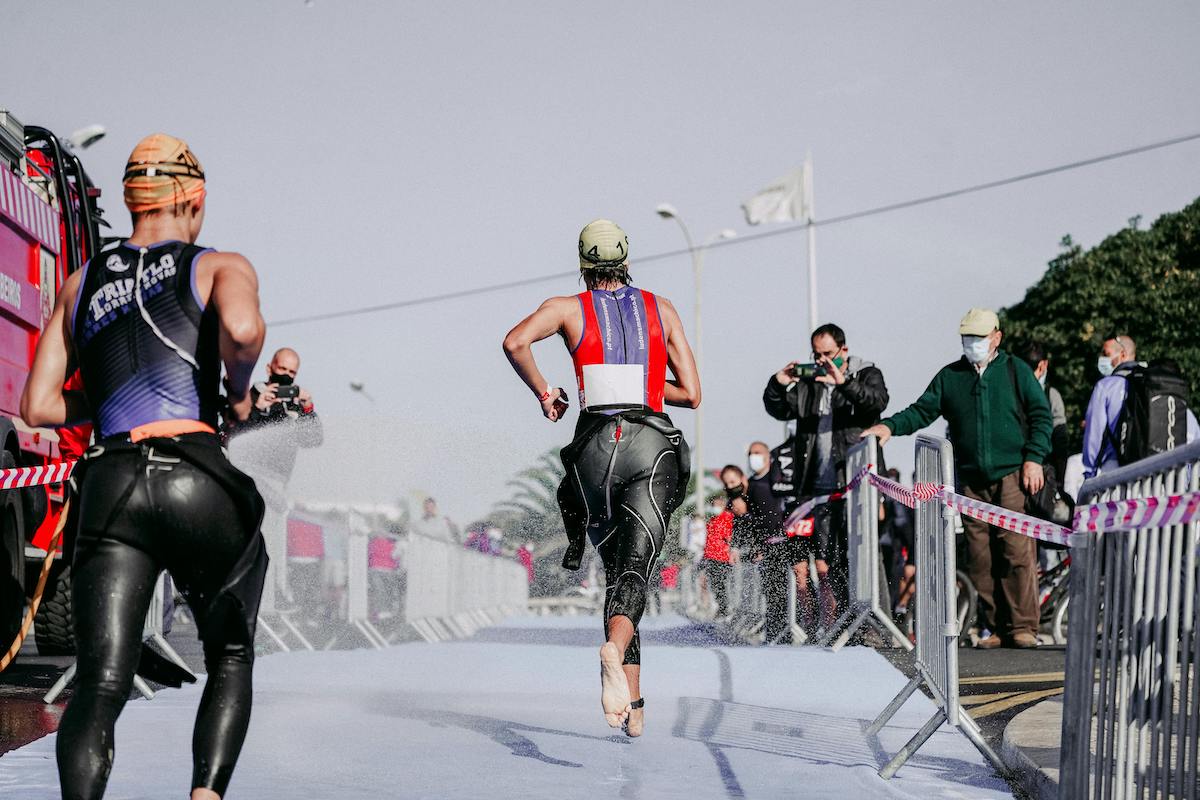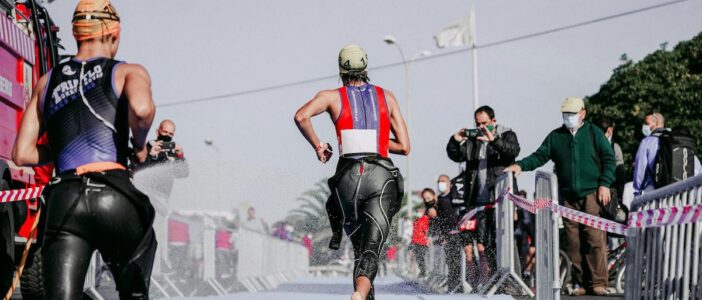Welcome to our FAQ section on triathlons! Whether you’re a beginner looking to dip your toes into the world of multisport racing or a seasoned triathlete seeking tips and insights, this section is designed to answer common questions and provide valuable information about all things triathlon-related.
A triathlon is a multisport race consisting of three continuous and sequential endurance disciplines: swimming, cycling, and running. Participants aim to complete each segment in the fastest time possible, transitioning between disciplines swiftly to minimize overall race time.
Triathlons vary in distance, with the most common being the sprint, Olympic, half Ironman, and Ironman distances. Sprint triathlons typically comprise a 750-meter swim, 20-kilometer bike ride, and 5-kilometer run, while Ironman triathlons can span a 3.86-kilometer swim, 180.25-kilometer bike ride, and a full marathon-distance run of 42.20 kilometers.
The sport demands high levels of physical fitness, mental resilience, and strategic planning, as athletes must efficiently manage their energy and pacing across three demanding disciplines. Triathlons offer a unique test of endurance, requiring athletes to excel in swimming, cycling, and running while seamlessly transitioning between each leg of the race.
From training advice and race preparation tips to gear recommendations and nutrition strategies, we’ve got you covered. Let’s dive in and explore everything you need to know about conquering the swim, bike, run – and everything in between – in the exhilarating world of triathlons.
Triathlon FAQ
- What's the best way to prevent chafing during a triathlon?
The best way to prevent chafing is by wearing moisture-wicking clothing, applying lubricants to areas prone to friction, and ensuring proper fitting attire with no abrasive seams. Additionally, stay hydrated to reduce salt buildup, which can exacerbate chafing.
- What type of shoes should I wear for the cycling and running legs?
For cycling, use clipless cycling shoes with compatible pedals for efficient power transfer. For running, choose lightweight, breathable running shoes with adequate cushioning and support to minimize fatigue and maximize performance.
- What should I wear during the swim, bike, and run portions?
- Should I wear socks for my triathlon cycle and run?
Wearing socks is a personal preference. Some athletes prefer the comfort and blister prevention that socks provide, while others opt to go sockless for quicker transitions and a more natural feel in their shoes.
- How do I prevent chafing during a triathlon?
To prevent chafing, apply lubricant or anti-chafing products to areas prone to friction, such as underarms, inner thighs, and neckline. Additionally, choose moisture-wicking clothing with flat seams and consider body glide or similar products.
- How do I choose the right wetsuit for the swim portion?
Select a wetsuit that offers buoyancy, flexibility, and a snug fit without restricting movement. Look for features such as smooth neoprene construction, strategically placed panels, and a comfortable neckline to enhance performance.
- How do I choose the right size for a triathlon wetsuit or clothing?
Refer to the sizing charts provided by manufacturers and take accurate measurements of your height, weight, chest, waist, and hip circumference. Additionally, consider trying on different sizes to ensure a snug yet comfortable fit.
- Do I wear my triathlon outfit under the wetsuit?
- Do I need to change clothes between each leg of the triathlon?
Changing clothes is optional and depends on personal preference and race strategy. Some athletes opt for quick transitions and wear the same outfit throughout, while others may change for comfort or performance reasons.
- Can I wear a wetsuit in all water temperatures?
While you can wear a wetsuit in various water temperatures, it’s essential to consider comfort and race regulations. In warmer conditions, a wetsuit may lead to overheating, so assess water temperature and personal preference.
- Can I wear a sports bra during the entire race?
Yes, wearing a sports bra throughout the race is common and recommended for comfort and support during all stages of the triathlon. Ensure it fits well and provides adequate support for the duration of the event.
- Are wetsuits necessary for all triathlons, or only certain ones?
- Are there triathlon-specific clothing brands or can I use regular athletic wear?
There are brands specializing in triathlon clothing, offering features like quick-drying, water-repellent materials, and streamlined designs. However, you can also use regular athletic wear if it’s comfortable and suitable for the race.
- Are there specific helmets for different types of cycling?
Yes, there are helmets designed for various types of cycling such as road, mountain, and time trial. Each type offers specific features tailored to the demands and aerodynamics of the particular discipline.
- Are there any guidelines for choosing the right sock for a triathlon?
- What's the "brick" training and why is it important?
“Brick” training involves combining two disciplines of a triathlon, such as cycling and running, in one workout to simulate the race-day experience and improve transition efficiency. This type of training helps your body adapt to the unique demands of transitioning between activities and builds muscular and mental endurance.
- How do I train for a triathlon?
Training for a triathlon requires a well-rounded approach that includes swimming, cycling, and running workouts. Develop a training plan that gradually increases in intensity and duration, incorporates rest days for recovery, and includes brick workouts to simulate the transitions between disciplines. Consistency and variety are key.
- How do I recover properly after completing a triathlon?
Proper recovery after completing a triathlon is essential for muscle repair and replenishing energy stores. Focus on hydration, nutrition, rest, and active recovery techniques such as light exercise, stretching, and massage. Give yourself time to recover mentally and physically before returning to intense training.
- How do I prevent injuries while training for a triathlon?
To prevent injuries while training for a triathlon, prioritize proper warm-up and cool-down routines, incorporate strength training to improve muscle imbalances and stability, gradually increase training intensity and duration, listen to your body and rest when needed, and consider cross-training to reduce overuse injuries.
- Triathlon Nutrition
For the bike leg of a triathlon, a hydration system that can be mounted on your bike is recommended for convenience and accessibility. Options include aerodynamic water bottles that fit into specially designed cages on the bike frame or hydration systems integrated into the handlebars or behind the saddle.
- How do I stay hydrated during a triathlon?
Staying hydrated during a triathlon is crucial for performance and health. Carry a hydration pack or water bottle during the race and drink small sips regularly. Practice hydration strategies during training to determine what works best for you, and consider electrolyte replenishment for longer events.
- Triathlon Equipment
- What type of bike is best for a triathlon?
- What are the essential gear and equipment needed for a triathlon?
Essential gear for a triathlon includes a swimsuit or wetsuit, goggles, a bike (road or triathlon-specific), a helmet, cycling shoes, running shoes, and clothing suitable for all three disciplines. Nutritional items and hydration systems are also crucial.
- Should I use a road bike or a triathlon-specific bike?
Whether to use a road bike or a triathlon-specific bike depends on various factors such as your budget, experience level, and the specific demands of the race. Triathlon-specific bikes are designed for aerodynamics and speed but can be more expensive.
- Can I use a regular backpack for storing gear, or do I need a specific dry bag?
You can use a regular backpack for storing gear, but it’s recommended to use a specific dry bag designed for triathlon to ensure your gear stays dry during the swim leg and is easily accessible during transitions.
- Can I use a mountain bike for the cycling leg?
While you can use a mountain bike for the cycling leg of a triathlon, it’s generally not ideal due to its heavier frame and less aerodynamic design compared to road or triathlon-specific bikes.
- Are aerobars beneficial for the cycling portion of a triathlon?
Yes, aerobars can be beneficial for the cycling portion of a triathlon as they allow for a more aerodynamic position, reducing drag and conserving energy over long distances.

